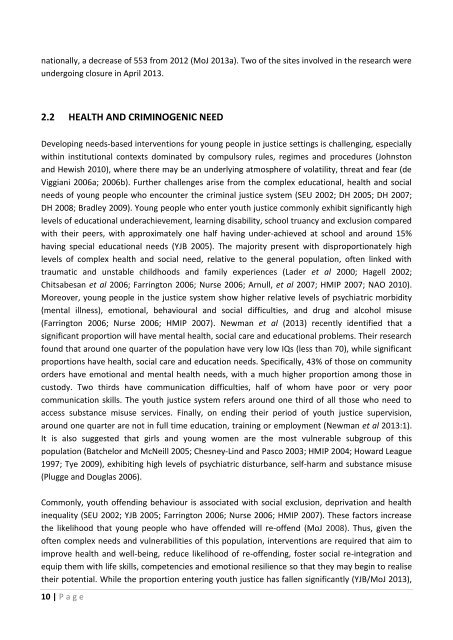De Viggiani, N., Daykin, N., Moriarty, Y. and Pilkington, P. and ...
De Viggiani, N., Daykin, N., Moriarty, Y. and Pilkington, P. and ...
De Viggiani, N., Daykin, N., Moriarty, Y. and Pilkington, P. and ...
You also want an ePaper? Increase the reach of your titles
YUMPU automatically turns print PDFs into web optimized ePapers that Google loves.
nationally, a decrease of 553 from 2012 (MoJ 2013a). Two of the sites involved in the research were<br />
undergoing closure in April 2013.<br />
2.2 HEALTH AND CRIMINOGENIC NEED<br />
<strong>De</strong>veloping needs-based interventions for young people in justice settings is challenging, especially<br />
within institutional contexts dominated by compulsory rules, regimes <strong>and</strong> procedures (Johnston<br />
<strong>and</strong> Hewish 2010), where there may be an underlying atmosphere of volatility, threat <strong>and</strong> fear (de<br />
<strong>Viggiani</strong> 2006a; 2006b). Further challenges arise from the complex educational, health <strong>and</strong> social<br />
needs of young people who encounter the criminal justice system (SEU 2002; DH 2005; DH 2007;<br />
DH 2008; Bradley 2009). Young people who enter youth justice commonly exhibit significantly high<br />
levels of educational underachievement, learning disability, school truancy <strong>and</strong> exclusion compared<br />
with their peers, with approximately one half having under-achieved at school <strong>and</strong> around 15%<br />
having special educational needs (YJB 2005). The majority present with disproportionately high<br />
levels of complex health <strong>and</strong> social need, relative to the general population, often linked with<br />
traumatic <strong>and</strong> unstable childhoods <strong>and</strong> family experiences (Lader et al 2000; Hagell 2002;<br />
Chitsabesan et al 2006; Farrington 2006; Nurse 2006; Arnull, et al 2007; HMIP 2007; NAO 2010).<br />
Moreover, young people in the justice system show higher relative levels of psychiatric morbidity<br />
(mental illness), emotional, behavioural <strong>and</strong> social difficulties, <strong>and</strong> drug <strong>and</strong> alcohol misuse<br />
(Farrington 2006; Nurse 2006; HMIP 2007). Newman et al (2013) recently identified that a<br />
significant proportion will have mental health, social care <strong>and</strong> educational problems. Their research<br />
found that around one quarter of the population have very low IQs (less than 70), while significant<br />
proportions have health, social care <strong>and</strong> education needs. Specifically, 43% of those on community<br />
orders have emotional <strong>and</strong> mental health needs, with a much higher proportion among those in<br />
custody. Two thirds have communication difficulties, half of whom have poor or very poor<br />
communication skills. The youth justice system refers around one third of all those who need to<br />
access substance misuse services. Finally, on ending their period of youth justice supervision,<br />
around one quarter are not in full time education, training or employment (Newman et al 2013:1).<br />
It is also suggested that girls <strong>and</strong> young women are the most vulnerable subgroup of this<br />
population (Batchelor <strong>and</strong> McNeill 2005; Chesney-Lind <strong>and</strong> Pasco 2003; HMIP 2004; Howard League<br />
1997; Tye 2009), exhibiting high levels of psychiatric disturbance, self-harm <strong>and</strong> substance misuse<br />
(Plugge <strong>and</strong> Douglas 2006).<br />
Commonly, youth offending behaviour is associated with social exclusion, deprivation <strong>and</strong> health<br />
inequality (SEU 2002; YJB 2005; Farrington 2006; Nurse 2006; HMIP 2007). These factors increase<br />
the likelihood that young people who have offended will re-offend (MoJ 2008). Thus, given the<br />
often complex needs <strong>and</strong> vulnerabilities of this population, interventions are required that aim to<br />
improve health <strong>and</strong> well-being, reduce likelihood of re-offending, foster social re-integration <strong>and</strong><br />
equip them with life skills, competencies <strong>and</strong> emotional resilience so that they may begin to realise<br />
their potential. While the proportion entering youth justice has fallen significantly (YJB/MoJ 2013),<br />
10 | P a g e
















